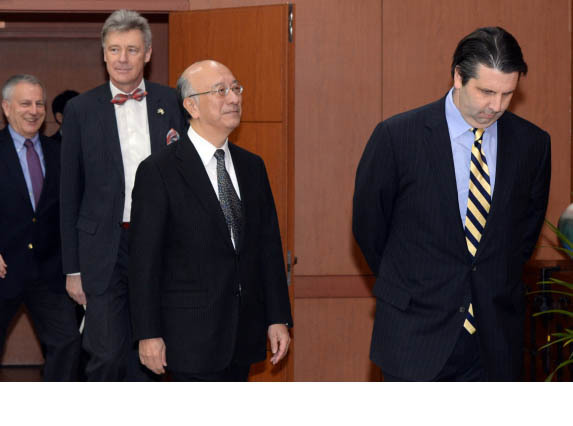Defense Minister Han Min-koo on Friday pledged to take an “active” response to North Korea’s looming missile test, raising the possibility of a surprise launch and calling for airtight military readiness and effective utility of reconnaissance assets.
Han convened a meeting with senior officials at the ministry and Joint Chiefs of Staff to assess the current security situation and review its military readiness after Pyongyang unveiled plans to fire a long-range rocket between Feb. 8 and 25.
The communist state appears to be speeding up preparations at its northwestern launch station, with intensified vehicle and gear installation activities spotted by commercial satellites.
“Our military is under a situation where it must maintain extraordinary mental and physical readiness posture since North Korea preannounced a long-range missile liftoff following a nuclear experiment. We ought to react actively,” Han said at the session, adding that the launch may come unexpectedly regardless of the notified window.
“We should be fully ready to detect signs of an imminent launch and the missile’s flight state in real time and operate the available South Korea-U.S. surveillance and reconnaissance assets in an effective manner so as to minimize any surveillance vacuum.”
 |
|
Defense Minister Han Min-koo (far right) attends a meeting with senior officials and Joint Chiefs of Staff on Friday at the ministry. (Yonhap) |
The Defense Ministry warned on Thursday it will shoot down a missile or its debris should it fall in its land or waters, saying it has completed the stationing of related assets such as the Patriot Advanced Capability-2 interception system.
The JCS vice chairmen of South Korea, the U.S. and Japan held a video conference on Friday to share information on the forthcoming firing and coordinate their responses.
“As the declared period draws near, we are closely tracking and monitoring the North’s movement with the possibility that preparations have made considerable headway in mind,” a ministry official told reporters on Friday, without elaborating.
Meanwhile, Foreign Minister Yun Byung-se, held talks on Friday with foreign envoys here to discuss North Korea’s fourth nuclear test last month and its impending missile test.
Attending the group meeting were U.S. Ambassador Mark Lippert, Japanese Ambassador Koro Bessho, Australian Ambassador William Paterson and Ambassador Gerhard Sabathil, head of the Delegation of the European Union to Seoul.
 |
| U.S. Ambassador Mark Lippert(from right), Japanese Ambassador Koro Bessho, EU Ambassador Gerhard Sabathil and Australian Ambassador William Paterson walk in for talks on Friday with South Korean Foreign Minister Yun Byung-se over North Korea’s Jan. 6 nuclear test and the impending “missile” launch. (Yonhap) |
The gathering came as the U.S. and China continue to tussle over the content and language of a new U.N. Security Council resolution to be introduced in response to the Jan. 6 underground detonation.
Though Seoul, Washington and other like-minded nations are ramping up diplomatic efforts, a draft resolution is yet to be passed around, officials here said, due chiefly to Beijing’s resistance to stronger, more sophisticated sanctions against its unruly neighbor.
But a panel of experts is expected to recommend new measures to a U.N. committee in charge of North Korea sanctions as early as next week. After a review, the committee is likely to bring these measures to the U.N. Security Council early next month.
“Despite the ongoing consultations of various forms, there is no momentum yet between the U.S. and China,” a senior Foreign Ministry official told reporters on customary condition of anonymity.
“Now that the North has announced its missile launch plan, talks are taking place over what kind of impact it will have on the current UNSC discussions. I assume it could make some difference in the timing of the resolution’s adoption or its substance, depending on when the missile takes off.”
In a fresh show of force, following large-scale exercises around border islands in the West Sea by the Marine Corps and separately in the East Sea by the Navy a day earlier, the Army on Friday unveiled the firepower of its recently deployed next-generation multiple launch rocket systems for the first time during a live drill.
The domestically built MLRS, named “Chunmoo,” has a range of up to 80 kilometers, more than twice that of the previous “Guryong.” Its precision strike force can burn to the ground an area as large as three football fields combined all at once, out of the range of North Korean long-range artillery weapons, the Army said.
By Shin Hyon-hee (heeshin@heraldcorp.com)

